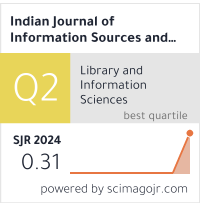Social Media Advertising for Small-Medium Scale Enterprises in Kumasi, Ghana
DOI:
https://doi.org/10.51983/ijiss-2022.12.2.3358Keywords:
Social Media, Social Media Advertising, SMEs, KumasiAbstract
This study focuses on social media advertising as one of the modes of communication which could be used to promote products and services. The present research sought to find out the extent to which social media advertising is making an impact on SMEs in the Kumasi Metropolis. A qualitative research approach with emphasis on case study as a research design was employed. Data was collected from 17 respondents in the form of face to face interviews from artisans working in a range of small medium scale enterprises within the Kumasi Metropolis, specifically in the Bomso, Anloga Junction and Afful Nkwanta catchment areas. Two major themes emerged from the findings: “social media for business promotion” and “perceptions of artisans on social media”. The findings suggest that there is the need for an intensive education on the use and importance of social media advertising for business purposes and the perceptions of the artisans about social media advertising could be explored for future research with regard to policy and practice.
References
Apenteng, A. S., & Doe, P. N. (2014). Social Media & Business Growth: Why Small/Medium-Scale Enterprises in the Developing World Should Take an Advantage of it (A Case of the country Ghana). Journal of Business and Management, 16(5), 76-80.
Ajzen, I. (1991). The Theory of Planned Behavior organizational Behavior and Human Decision Processes. Taylor, S. and Todd, PA (1995) Understanding information technology Usage: A test of competing models, Information Systems Research, 6(2), 144-176.
Ala-Mutka, K., Broster, D., Cachia, R., Centeno, C., Feijóo, C., Haché, A., Kluzer, S., Lindmark, S., Lusoli, W., Misuraca, G., & Pascu, C. (2009). The impact of social computing on the EU information society and economy. JRC Scientific and Technical Report EUR, 24063.
Al Tawara, A., & Gide, E. (2017). A Comprehensive Literature Review on the Adoption of Social Media Marketing in SME Retailors in Jordan.
Barker, M. S., Donald L. B., Nicholas F. B., & Krista E. N. (2013). Social media marketing: A strategic approach. Mason, OH: South-Western, Cengage Learning.
Barutçu, S., & Tomas, M. (2013). Measurement of Sustainable Social Media Marketing and Social Media Marketing Efficiency. Journal of Internet Applications & Management Dergis, 4(1), 5-24. DOI: 10.5505/iuyd.2013.69188.
Basford, L., & Slevin, O. (Eds.). (2003). Theory and practice of nursing: An integrated approach. Nelson Thornes.
Baş, Y., Gümüş, N., & Cop, R. (2010). The Impact of Social Bookmarking Sites on Consumer Decisions as a Marketing Communication Tool and a Research 15. National Marketing Congress İzmir.
Bhaskaran, S. (2013). Structured case studies: Information communication technology adoption by small‐to‐medium food enterprises. British Food Journal, 115(3), 425-447, https://doi.org/10.1108/00070701311314237.
Bosua, R., Evans, N., & Sawyer, J. (2013). Social networks, social media, and absorptive capacity in regional small and medium enterprises (SMEs) in Australia. Australian and International Journal of Rural Education, 23(1), 1-18.
Boyatzis, R. (1982). The Competent Manager: A Model for Effective Performance. New York: John Wiley & Sons.
Boyatzis, R. E. (1998). Transforming qualitative information: thematic analysis and code development. Sage Publications.
Christensen, L., Johnson, R., & Turner, L. A. (2015). Research Methods, Design and Analysis, 12th edn., Pearson, Edinburgh, England.
Cohen, L., Manion, L., & Morrison, K. (2007). Research methods in education, 6th edn, London, Routledge.
Creswell, J. W. (2008). Educational research: Planning, conducting, and evaluating quantitative and qualitative research (3rd ed.). Upper Saddle River, NJ: Merrill.
Creswell, J. W. (2014). Research Design: Qualitative, quantitative and mixed methods approaches, 4th edn., Sage Publications.
Crotty, M. (1998). The foundations of social research. London, Thousand Oaks, New Delhi: SAGE publications.
Daj, A. (2013). Economic and legal aspects of introducing novel TCT instruments: Integrating sound into social media marketing - from audio branding to sound scaping. Economic Sciences, 6(2), 15-24.
Drury, G. (2008). Opinion Piece: Social Media: Should Marketers Engage and How Can it be done effectively? Journal of direct data and digital marketing practice, 9, 274-277.
Easterby-Smith, M., Golden-Biddle, K., and Locke, K. (2008). Working with pluralism: determining quality in qualitative research. Organizational Research Methods, 11(3), 419-429.
Ekinci, K. (2010). Social Media Today. Retrieved on October 27, 2012, from 25 “P”s of Social and New Media Marketing: http://socialmediatoday.com/officedivvy/154631/25-ps-social-and-new-mediamarketing.
Eriksson, P., & Kovalainen, A. (2008). Qualitative Methods in Business Research, 1st ed, SAGE Publications Ltd., London.
Evans, D. (2010). Social media marketing: The next generation of business engagement. Sybex: Wiley Publishing.
Festinger, L., Schachter, S., & Back, K. (1950). Social pressures in informal groups; a study of human factors in housing. Fliegel, F. C. & Kivlin, J. E. (1966). Attributes of Innovations as Factors in Diffusion. American Journal of Sociology, 72(3), 235-248.
Frain, A. (2014). Leadership in Power. Retrieved December 13, 2017, from https://socialidentityresources.com/2014/06/19/understanding-power-authority-and-coercion.
Gephart, R. (1999). Paradigms and Research Methods: http://division.aomonline.org/rm/1999.RMDForum_Paradigms-and- Research. Accessed January 2009.
Global Web Index Q4. (2016). Social Summary (Global Web Index’s quarterly report on the latest trends in social networking), London, UK. Available at: https://cdn2.hubspot.net/hubfs/304927/Downloads/GWI-Social-Q4-2016-Summary.pdf (Accessed: 19 June 2018).
Grix, J. (2004). The foundations of research, London, Palgrave Macmillan.
Guba, E. (1990). The Paradigm Dialog. London: Sage.
Gümüş, N., & Kütahyali, D. N. (2017). Perceptions of Social Media by Small and Medium Enterprises (SMEs) in Turkey. International Journal of Business and Information. DOI: 10.6702/ijbi.2017.12.2.2. [Accessed Jul 23, 2018].
Gunelius, S. (2011). 30 minute social media marketing: Step by step techniques to spread the word about your business fast and free. United States: McGraw-Hill.
Hassan, S., Nadzim, S. Z. A., & Shiratuddin, N. (2015). Strategic Use of Social Media for Small Business Based on the AIDA Model. Procedia-Social and Behavioral Sciences, 172, 262-269.
Hatfield, J. L. (2017). Determinants of motivation and self-regulation in aspiring musicians. The mental edge of musicianship.
Henning, E., Van Rensburg, W., & Smit, B. (2004). Finding your way in qualitative research. Pretoria: Van Schaik.
Hubspot. (2012). 120 Marketing Stats, Charts & Graphs. Available from http://hubspot.com [accessed June 23, 2018].
Hurley, C. (2009). ‘YouTube’ Hurley, C Blog, Retrieved December 13, (2017) Retrieved from http://youtube-global.blogspot.com/2009/10/youtube.html
Jaokar, A., Jacobs, B., Moore, A., & Ahvenainen, J. (2009). Social Media Marketing: How data analytics helps to monetize the user base in telecoms, social networks, media and advertising in a converged ecosystem. London: Future text.
Katz, E. (1959). Mass communications research and the study of popular culture: An editorial note on a possible future for this journal. Studies in public communication, 2, 1.
Kirkland, C. (2011). E-consultancy. Retrieved on November 4, 2012, from 14 epic social media fails: http://econsultancy.com/uk/blog/7913-14-epic-social-media-fails
Kothari, C. R. (2004). Research Methodology: Methods and techniques, 2nd rev. edn., New Age International Publishers, New Delhi, India.
Lacho, K. J., & Marinello, C. (2010). How small business owners can use social networking to promote their business. The Entrepreneurial Executive.
Landa, R. (2004). Advertising by design: Creating visual communications with graphic impact. John Wiley & Sons. Vancouver.
Lemanski, T., & Overton, T. (2011). UK Physical Sciences Centre: An Introduction to Qualitative Research. Retrieved April 30, 2013, from http://www.heacademy.ac.uk/assets/ps/documents/primers/primers/qualitative_research.pdf.
Mangold, W. G., & Faulds, D. J. (2009). Social media: The new hybrid element of the promotion mix. Business horizons, 52(4), 357-365.
Marketo. (2016). The definition guide to Social Media Marketing. Retrieved from https://www.scribd.com/document/358591719/The-Definitive-Guide-to-Social-Media-Marketing-Marketo.
Maymann, J. (2008). The Social Metropolis. Cincinnati: Go Viral.
Mbambo, B., & Cronjé, J. C. (2002). The Internet as an information conduit in developing countries: an investigation of World Wide Web usability among small and medium textile enterprises in Botswana. Aslib Proceedings, 54(4), 251-259, https://doi.org/10.1108/00012530210443357.
Mchombu, K. J. (1995). Impact of information on rural development: Background, methodology and progress. Making a difference: Measuring the impact of information on development. Ottawa: International Development Research Centre, 87-102. Vancouver.
Menou, M. J. (1993). Measuring the Impact of Information Development, International Centre for Research Development, Ottawa.
Ngai, E. W., Moon, K. L. K., Lam, S. S., Chin, E. S., & Tao, S. S. (2015). Social media models, technologies, and applications: an academic review and case study. Industrial Management & Data Systems, 115(5), 769-802.
Pelleth, Y. T. (2010). Towards Developing A Web-Based Blended Learning Environment at the University of Botswana, PhD Thesis, University of South Africa.
Petrescu, M. (2014). Viral marketing and social networks. Business Expert Press.
Resnik, D. B. (2011). What is ethics in research & why is it important. In The national.
Robson, C. (2002). Real World Research: A Resource for Social Scientists and Practitioner-Researchers. Oxford: Blackwell.
Rogers, E. M. (1983). Diffusion of innovations (3rd Edition). New York: Free Press.
Rogers, E. M. (1995). Diffusion of innovations (4th ed.). New York: Free Press.
Rogers, E. M. (2003). Diffusion of innovations (5th ed.). New York: Free Press.
Rugova, B., & Prenaj, B. (2016). Social Media as Marketing tool for SMEs: opportunities and challenges. Journal of Business, IIPCCL Publishing, Tirana-Albania, 2(3).
Ruane, J. (2005). Essentials of Research Methods: A Guide to Social Science Research. Malden: Blackwell Publishing.
Sahin, I. (2006). Detailed Review of Rogers’ Diffusion of Innovations Theory and Educational Technology-Related Studies Based on Rogers’ Theory. TOJET: The Turkish Online Journal of Educational Technology, 5(2).
Saunders, M., Lewis, P., & Thornhill, A. (2009). Research Methods for Business Students (5th ed.). Essex, England: Pearson Education Limited.
Saunders, M. N. (2011). Research methods for business students, 5/e. Pearson Education India.
Schram, W. (1996). Mass Media and National Development. Stanford University Press, Stanford, CA.
Scoble, R., & Israel, S. (2006). Naked conversations: How blogs are changing the way businesses talk with customers. Hoboken, NJ: John Wiley.
Sernovitz, A., Kawaski, G. & Godin, S. (2006). Word of mouth marketing. Dearborn Trade, A Kaplan Professional Company.
Sinclair, M. (2007). A guide to understanding theoretical and conceptual frameworks. Evidence-Based Midwifery, 5(2), 39-40.
Soy, S. K. (1997). The case study as a research method. Unpublished paper, University of Texas at Austin.
Stelzner, M. (2012). Social media marketing industry report: How marketers are using social media to grow their businesses.
Sutton, J. & Kpentey, B. (2012). An enterprise map of Ghana, International Growth Centre in association with the London Publishing Partnership, 2.
TerreBlanche, M., & Durrheim, K. (1999). Research in practice. Cape Town, UCT Press.
Teddlie, C., & Tashakkori, A. (2006). A general typology of research designs featuring mixed methods. Research in the Schools, 13(1), 12-28.
Terrell, S. R. (2016). Writing a Proposal for Your Dissertation: Guidelines and Examples. Guilford Publications, New York, London.
Thomas, P. Y. (2010). Towards developing a web-based blended learning environment at the University of Botswana (Doctoral dissertation).
Tuten, T. L. (2008). Social Media Marketing in a Web 2.0 World. New Jersey: Greenwood Publishing Group Inc.
Vollmer, C., & Precourt, G. (2008). Always on: Advertising, marketing, and media in an era of consumer control. New York: McGraw-Hill.
Walsham, G. (1993). Interpreting Information Systems in Organizations. Wiley, Chichester.
Walton, M. (2009). The Political Economy of India’s Malnutrition Puzzle. Institute of Development Studies Bulletin.
Wang, J. F. (2009). Building Social Networking Sites (SNS) on Open Source Platforms. The Business Review, Cambridge, 13(2), 32-38.
Wheeler, A. (2013). Designing brand identity. New Jersey: John Wiley and Sons Inc.
Yin, R. K. (1984). Case study research: Design and methods. Newbury Park, CA: Sage.
Downloads
Published
How to Cite
Issue
Section
License
Copyright (c) 2022 The Research Publication

This work is licensed under a Creative Commons Attribution-NonCommercial-NoDerivatives 4.0 International License.









